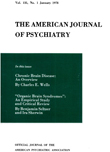Patterns of Utilization in Partial Hospitalization
Abstract
A sample of 176 patients admitted to a day and night hospital was studied in an attempt to identify factors predictive of complete utilization of a partial hospitalization program and to relate these specifically to the way in which such programs are now used and might be planned for the future. The clinical state of the patient, in terms of acuteness or chronicity, was found to be a more useful predictor than other criteria commonly used. The authors conclude that separate programs are required for acute and chronic patients, reflecting differing emphases and patient needs.
Access content
To read the fulltext, please use one of the options below to sign in or purchase access.- Personal login
- Institutional Login
- Sign in via OpenAthens
- Register for access
-
Please login/register if you wish to pair your device and check access availability.
Not a subscriber?
PsychiatryOnline subscription options offer access to the DSM-5 library, books, journals, CME, and patient resources. This all-in-one virtual library provides psychiatrists and mental health professionals with key resources for diagnosis, treatment, research, and professional development.
Need more help? PsychiatryOnline Customer Service may be reached by emailing [email protected] or by calling 800-368-5777 (in the U.S.) or 703-907-7322 (outside the U.S.).



